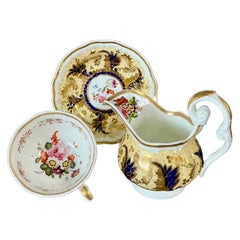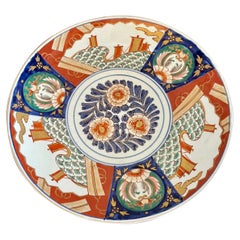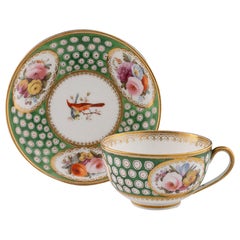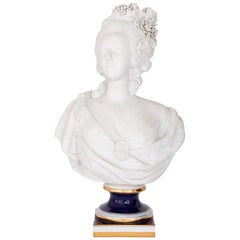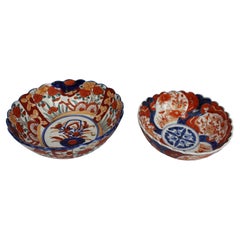United Kingdom - Porcelain
to
137
837
2
1
153
492
192
3
70
50
47
22
3
7
10
2
7
8
14
19
5
159
51
49
38
36
20
19
16
8
7
7
7
3
2
1
825
807
61
40
39
840
4,728
2,313
706
390
289
113
112
840
839
840
43
24
22
16
15
Item Ships From: United Kingdom
Samuel Alcock Teacup and Milk Jug, Pale Yellow, Gilt and Flowers, ca 1824
By Samuel Alcock & Co.
Located in London, GB
A teacup and saucer with milk jug in the “melted snow” shape with double drop handles, pale yellow ground with rich gilt and cobalt blue acanthus pattern and finely painted flower re...
Category
1820s English Regency Antique United Kingdom - Porcelain
Materials
Porcelain
$496 Sale Price / set
20% Off
Large Antique Japanese Quality Imari Charger
Located in Suffolk, GB
Large antique Japanese quality Imari charger having quality hand painted panels with flowers, leaves, trees, birds and ships in wonderful green, blue, red, white and gold colours
...
Category
Early 1900s Japanese Antique United Kingdom - Porcelain
Materials
Porcelain
Nantgarw Porcelain Teacup and Saucer 1818-20
By Nantgarw China Works
Located in Tunbridge Wells, GB
Heading : Nantgarw porcelain teacup and saucer
Date : 1818-20
Period :Regency
Origin : Nantgarw, Wales. Possibly London decorated
Colour : Polychrome
Pattern : Three garden flower pa...
Category
1820s British Regency Antique United Kingdom - Porcelain
Materials
Porcelain
Set of Three German Porcelain Bird Figures by Meissen
By Meissen Porcelain
Located in London, GB
Set of three German porcelain bird figures by Meissen
German, 20th Century
Largest (magpie): Height 21cm, width 10cm, depth 5cm
This exquisite t...
Category
20th Century German Rococo United Kingdom - Porcelain
Materials
Porcelain
Antique Biscuit Porcelain Figure of Queen Marie Antoinette
Located in London, GB
This antique bust of Marie Antoinette has been gracefully crafted in biscuit porcelain after the fashionable Sevres style. Biscuit, or bisque, describes the technique whereby the por...
Category
Late 19th Century French Louis XVI Antique United Kingdom - Porcelain
Materials
Porcelain
Pair of Japanese Imari Porcelain Bowls, Meiji Period, circa 1900
Located in Worcester, GB
Pair of Japanese Imari Porcelain Bowls, Meiji Period, circa 1900
A fine pair of Japanese Imari porcelain bowls dating to the Meiji period, circa 1900. Each of fluted circular form w...
Category
20th Century Japanese United Kingdom - Porcelain
Materials
Porcelain
German Schafer & Vater Attributed Porcelain Figural Scotsman Character Jug
By Schafer & Vater
Located in Bishop's Stortford, Hertfordshire
A delightful and unusual antique German porcelain figural Scotsman character jug attributed to Schafer & Vater dating from around 1900. This charming and quality jug stands on a flat...
Category
Late 19th Century German Aesthetic Movement Antique United Kingdom - Porcelain
Materials
Porcelain
Chelsea Plate, Feather Moulded with Flowers, Red Anchor Mark, ca 1755
By Chelsea Porcelain
Located in London, GB
This is a beautiful plate made by Chelsea in circa 1755, which is known as the "Red Anchor" period of the factory.
Chelsea was one of the very early adopters of porcelain in the British china industry. Founded in 1744 the Chelsea pottery was for about 40 years the leading maker of fine chinaware, excelling in their sense of style, perfection and constant innovation and inspiring many following generations of china makers.
The company was started by French silversmith Nicholas Sprimont and you can see the influence of the French style of silverware...
Category
1750s English George II Antique United Kingdom - Porcelain
Materials
Porcelain
$916 Sale Price
20% Off
Japanese Meji Period Satsuma Vase c1885
Located in Tunbridge Wells, GB
Heading : Japanese Meji period satsuma vase
Date : c1885
Origin : Japan - possibly Satsuma province although most likely decorated in Kobe or Yokohama.
Bowl Features : Imari palette ...
Category
1880s Japanese Antique United Kingdom - Porcelain
Materials
Porcelain
Quality Victorian Continental Porcelain Group Salt & Pepper Holder
Located in Ipswich, GB
Quality Antique Victorian continental porcelain group having a cherub with two shaped bowls for salt and pepper on a shaped base with quality hand painted birds and scroll decoration...
Category
Early 19th Century Victorian Antique United Kingdom - Porcelain
Materials
Porcelain
Samuel Alcock Plate, Inverted Shell, Flowers, Provenance G.A.Godden Regency 1822
By Samuel Alcock & Co.
Located in London, GB
This is a very striking and rare square dessert serving dish made by Samuel Alcock, circa 1822. The dish has a hand painted flower landscape in an unusual style. The dish has provena...
Category
1820s English Regency Antique United Kingdom - Porcelain
Materials
Porcelain
$340 Sale Price
20% Off
Sevres Porcelain Trembleuse Cup and Saucer First Size
By Manufacture Nationale de Sèvres
Located in Tunbridge Wells, GB
Heading : 18th Century Sevres 1st Size Trembleuse Cup and Saucer
Date : Late 18th Century c1790
Marks : Interlaced L mark in blue. Incised OO mark on b...
Category
1790s French Antique United Kingdom - Porcelain
Materials
Porcelain
Pair of Antique Sèvres Vases
By Manufacture Nationale de Sèvres
Located in Brighton, Sussex
A very fine quality pair of French ormolu-mounted jewelled Sèvres porcelain lidded vases. Having classical romantic scenes and landscapes set between the cobalt blue, the gilded ormo...
Category
19th Century French Antique United Kingdom - Porcelain
Materials
Ormolu
$34,068 / set
Pair of Decorative French Antique Butter Dishes by Ruaud
By Ruaud
Located in London, GB
Pair of decorative French antique butter dishes by Ruaud
French, c. 1860
Height 14cm, width 19cm, depth 10cm
These charming 19th-century butter dishes reflect the whimsical creativity of mid-Victorian design. Made by Ruaud, a Limoges porcelain maker active between 1829 and 1869, each dish takes the form of a miniature sofa...
Category
1860s French Victorian Antique United Kingdom - Porcelain
Materials
Porcelain
18th Century Chinese Export Porcelain Dish Blue & White hand painted immortals
Located in Lincoln, Lincolnshire
This is a hand-painted Chinese Export porcelain Dish, which we date to the second half of the 18th century, Qing, Qianlong period, circa 1770, or possibly earlier.
The dish is circu...
Category
Mid-18th Century Chinese Qing Antique United Kingdom - Porcelain
Materials
Porcelain
Chelsea-Derby Chocolate Cup Set, Gilt Stripes, Puce Flowers, Rococo 1770-1775
By Chelsea-Derby, Chelsea Porcelain, Derby
Located in London, GB
This is a beautiful chocolate cup set made by Chelsea-Derby between 1770 and 1775, which was the Rococo era. The set consists of a cup, a saucer and a cover, and is decorated in a st...
Category
1770s English Rococo Antique United Kingdom - Porcelain
Materials
Porcelain
$940 Sale Price / set
23% Off
19th Century Russian Gilt Porcelain Centrepiece by Popov Manufactory
Located in London, GB
This exquisite centrepiece was crafted in porcelain and gilt by the Russian Popov Manufactory. The centerpiece is of bowl-form, and is crafted in white porcelain which is pierced wit...
Category
19th Century Russian Neoclassical Antique United Kingdom - Porcelain
Materials
Porcelain
Pair of Antique Florally Decorated Porcelain Lamps
By Manufacture Nationale de Sèvres
Located in London, GB
Pair of antique florally decorated porcelain lamps
French, 19th century
Measures: With shades: Height 101cm, width 49cm, depth 36cm
Withou...
Category
19th Century French Rococo Antique United Kingdom - Porcelain
Materials
Porcelain
$16,352 / set
Nantgarw Porcelain Teacup and Saucer 1818-20
By Nantgarw China Works
Located in Tunbridge Wells, GB
Heading : Nantgarw porcelain teacup and saucer
Date : 1818-20
Period :Regency
Origin : Nantgarw, Wales. Possibly London decorated
Colour : Polychrome
Pattern : Three garden flower pa...
Category
1810s British Regency Antique United Kingdom - Porcelain
Materials
Porcelain
Bejewelled 19th Century Sevres Style Clock Set
Located in London, GB
A fine quality 19th century French Sevres porcelain style and gilded ormolu clock garniture, impressive pair of four branch candelabra.
Measures: Clock, H: 53cm, D: 24cm, W: 27cm...
Category
Late 19th Century French Antique United Kingdom - Porcelain
Materials
Bronze
Bow Porcelain Figure of Boy Putto on C-Scroll Base, Georgian circa 1760
By Bow Porcelain
Located in London, GB
This is a wonderful little figure of a boy or putto made by the Bow Porcelain factory in about 1760.
The Bow Porcelain Factory was one of the first potteries in Britain to make soft...
Category
1760s English Rococo Antique United Kingdom - Porcelain
Materials
Porcelain
$548 Sale Price
45% Off
Samuel Alcock Porcelain Teacup, White with Flower Sprays, ca 1823
By Samuel Alcock & Co.
Located in London, GB
A teacup and saucer in the “half orange” shape, white with simple gilt rim and beautiful hand painted flower sprays
Pattern unknown but similar to 1082
Year: ca 1823
Size: cup diameter 10cm (4”), saucer diameter 14.2cm (5.5”)
Condition: excellent, some rubbing to gilt
There are several items available in this design, please see group image and ask for more info if interested.
The Samuel Alcock factory was operative in Staffordshire between 1822 and 1856, after which it was bought by Sir James Duke and Nephews. The factory started as a partnership between the young Samuel Alcock and the older Ralph Stevenson, who provided the factory and capital. Alcock quickly took the factory to great heights, building one of the biggest factories of its time. Alcock jumped on the new Rococo Revival fashion and served a huge new middle class market. The reason we now don't hear much about Samuel Alcock porcelain...
Category
1820s English Regency Antique United Kingdom - Porcelain
Materials
Porcelain
$292 Sale Price / set
20% Off
Six Rococo Sèvres Style Porcelain Plates
By Manufacture Nationale de Sèvres
Located in London, GB
Each porcelain plate in this set of six features a navy-blue ground, distinctive to works produced in the style of Sèvres, and gilded rims with ornate patterns inscribed. The centre ...
Category
19th Century French Rococo Antique United Kingdom - Porcelain
Materials
Porcelain
$16,352 / set
Set of twenty four blue and white floral porcelain dinner plates
Located in London, GB
Set of twenty four blue and white floral porcelain dinner plates
Continental, 19th Century
Height 2.5cm, diameter 23.5cm
These blue and white porcelain dinner plates...
Category
19th Century European Belle Époque Antique United Kingdom - Porcelain
Materials
Porcelain
Sevres style porcelain Comport, circa 1890.
By Cristalleries De Sevres
Located in Brighton, Sussex
A very good quality French Sevres porcelain comport, having wonderful gilded ormolu scrolling foliate mounts, with cherubs seated , the cobalt blue ground porcelain with inset hand p...
Category
Late 19th Century French Antique United Kingdom - Porcelain
Materials
Ormolu
Raymond Loewy for Rosenthal ‘Form 2000' Coffee Pot, Designed 1954, White Ceramic
By Raymond Loewy, Rosenthal
Located in London, GB
Raymond Loewy and Richard Latham for Rosenthal, 1954
‘Form 2000’ Coffee Pot
A lovely example of this design classic
White ceramic with gold edging
Exce...
Category
1950s German Mid-Century Modern Vintage United Kingdom - Porcelain
Materials
Ceramic
$107 Sale Price
25% Off
Very Large Giltwood Framed K.P.M. Porcelain Plaque of Jephthah's Daughter
By Königliche Porzellan-Manufaktur (KPM)
Located in London, GB
A very large giltwood framed K.P.M. porcelain plaque of Jephthah's daughter
German, late 19th century
Frame: height 97cm, width 84cm, depth 8cm
Plaque: height 65cm, width 52cm
...
Category
Late 19th Century German Antique United Kingdom - Porcelain
Materials
Porcelain, Giltwood
Pair of Large Vintage 80s Rococo Regency Vases By Agostinelli Italy for Harrods
By Harrods, Porcellane D'arte Agostinelli
Located in Llanbrynmair, GB
These exquisite vintage porcelain vases from the 1980s, crafted by Agostinelli, Italy and sold by Harrods, epitomize the luxurious Rococo Regency style. The vases are adorned in a st...
Category
1980s Italian Rococo Vintage United Kingdom - Porcelain
Materials
Porcelain
18thC Chinese Export Porcelain Bowl Hand Painted Famille Rose, Qing Ca 1780
Located in Lincoln, Lincolnshire
This is a hand painted Chinese export bowl from the late 18th century, Qing dynasty, Qianlong period, 1736-1795. We date this piece to...
Category
18th Century Chinese Chinese Export Antique United Kingdom - Porcelain
Materials
Porcelain
Copeland Porcelain Plaque Depicting the Casket Scene from the Merchant of Venice
By Copeland
Located in London, GB
Copeland porcelain plaque depicting the Casket Scene from The Merchant of Venice
English, Late 19th Century
Frame: height 47.5cm, width 65.5cm, de...
Category
Late 19th Century English Victorian Antique United Kingdom - Porcelain
Materials
Porcelain, Giltwood
Massive Sevres Style Porcelain and Gilt Bronze Centrepiece
Located in London, GB
19th century sevres style centrepiece with impressive gilding all around it.
Category
Late 19th Century French Antique United Kingdom - Porcelain
Materials
Porcelain
Meissen Mandarin Duck Max Esser Art Deco
By Max Esser, Meissen Porcelain
Located in Newark, England
Chinese Mandarin Duck
From our Ceramics collection, we are delighted to offer this Meissen Mandarin Duck Modelled by Max Esser. The Meissen Mandarin Duck beautifully sculpted in nat...
Category
Early 20th Century German Art Deco United Kingdom - Porcelain
Materials
Porcelain
William Mehornay Studio Pottery Porcelain White Glazed Vase, 1974-1975
By William Mehornay
Located in Bishop's Stortford, Hertfordshire
We have recently been extremely privileged to meet acclaimed American born studio potter and artist William Mehornay. We are also greatly honored for him to have entrusted to us piec...
Category
1970s British Vintage United Kingdom - Porcelain
Materials
Ceramic, Porcelain
Very Fine Gilt Bronze, Cloisonné Enamel and Porcelain Holy Water Stoup
Located in London, GB
A very fine gilt bronze, cloisonné enamel and porcelain holy water stoup
French, late 19th century
Measures: Height 54cm, width 34cm, depth 9cm
This b...
Category
Late 19th Century French Renaissance Antique United Kingdom - Porcelain
Materials
Enamel, Ormolu
Late 19th Century Vienna Style Porcelain Plate, Depicting Duchess of Devonshire
By Royal Vienna Porcelain
Located in Brighton, Sussex
A very good quality late 19th Century Austrian, Vienna style porcelain plate, having classical gilded and burgundy boarders with an inset hand painted portrait of the " Duchess of Devonshire...
Category
Late 19th Century Austrian Romantic Antique United Kingdom - Porcelain
Materials
Porcelain
Pair of Japanese Imari plates
Located in Cheshire, GB
Pair of Japanese Imari plates decorated in the typical palette with cranes.
Dimensions
Height 3 Inches
Length 16.5 Inches
Width 16.5 Inches
Category
19th Century Japanese Antique United Kingdom - Porcelain
Materials
Porcelain
$2,173 / set
Rare Georgian Porcelain Coffee Can by Machin & Baggaley Ptn 262, Circa 1810
By Machin and Baggaley
Located in Lincoln, Lincolnshire
This is an early 19th century porcelain coffee can or cup that we attribute to Machin and Baggaley (or Machin & Co.) of Burslem, Staffordshire, England.
Early Machin porcelain pieces tend to be rare.
This coffee can is nominally straight sided and has a good ring handle with a long pointed lower support. It is beautifully hand decorated with a striking floral design having large pink flowers...
Category
Early 19th Century English George III Antique United Kingdom - Porcelain
Materials
Porcelain
A pair of French blue and white Delft style vases circa 1900 by Samson of Paris
Located in Central England, GB
A very decorative pair of French porcelain blue and white hand painted vases made by Samson of Paris to imitate 19th century Delft po...
Category
Early 1900s French Louis Philippe Antique United Kingdom - Porcelain
Materials
Porcelain
Chinese Qing Sancai Glazed Immortal Figure
Located in Bishop's Stortford, Hertfordshire
A fine antique Chinese porcelain figure of Immortal decorated in sancai glazes dating from 19th century. The figure stands raised on a six-sided pedestal...
Category
19th Century Asian Qing Antique United Kingdom - Porcelain
Materials
Porcelain
Naples Capodimonte Porcelain Lidded Tankard, Italian Early 19th Century
By Capodimonte
Located in Lincoln, Lincolnshire
This is a Naples (Capodimonte) Porcelain Lidded Tankard with deep relief body, which we date to the early 19th Century and made in Naples, Italy.
The tankard is hand made with deep ...
Category
Early 19th Century Italian Classical Roman Antique United Kingdom - Porcelain
Materials
Porcelain
Pair of Antique Porcelain Sconces by Meissen
By Meissen Porcelain
Located in London, GB
Pair of antique porcelain sconces by Meissen
German, late 19th Century
Measures: Height 57cm, width 38cm, depth 10cm
This fine pair of Ge...
Category
Late 19th Century German Rococo Antique United Kingdom - Porcelain
Materials
Porcelain
$24,528 / set
Early 20th Century Flower Encrusted Tete a Tete 'Tea for Two'
Located in London, GB
The service comprising of two cups and saucers, milk jug, sugar pot and lid and a tea/coffeepot.
The design stems from the service made for Frederik II of Prussia.
Category
Early 20th Century German Neoclassical United Kingdom - Porcelain
Materials
Porcelain
Hans Theo Bauman, Arzberg ‘Brasilia’ coffee pot with ‘Viola’ decoration, 1970s
By Arzberg, Hans Theo Baumann
Located in London, GB
Hans Theo Bauman (Swiss/German, 1924-2016)
‘Brasilia’ coffee pot with ‘Viola’ flower pattern, Model no. ‘Arzberg 5500’
Designed 1975, produced by Arzberg,...
Category
1970s German Mid-Century Modern Vintage United Kingdom - Porcelain
Materials
Ceramic
Belgian Porcelan Marmalade Jars
Located in Haywards Heath, GB
Originally used for Marmalade or Pate, these come with lovely original blue manufacturer stamp 'Mirland & Co'.
Each item is unique from the 1930s and was originally sourced directly...
Category
20th Century Belgian United Kingdom - Porcelain
Materials
Porcelain
$36 / item
Pair of Large Sèvres-style Porcelain and Gilt-Metal Vases
By Manufacture Nationale de Sèvres
Located in London, GB
Pair of large Sèvres-style porcelain and gilt-metal vases.
French, 20th century
Measures: height 97cm, width 42cm, depth 30cm
With covers, el...
Category
20th Century French Rococo United Kingdom - Porcelain
Materials
Porcelain
19th Century English Porcelain Garniture
By Coalport Porcelain
Located in London, GB
A garniture of Minton or Coalport vases, circa 1830, in the C18 Meissen style with appliqué handmade ceramic flowers encrusted all-over.
Category
Early 19th Century English Neoclassical Revival Antique United Kingdom - Porcelain
Materials
Porcelain
$1,975 / item
Pair Dresden Porcelain Swans
By Dresden Porcelain
Located in Brighton, Sussex
Pair Dresden porcelain hand painted Swans each with wonderful bold colouring, signed to the base in blue Dresden and stamped. Measure: 11".
Category
Early 20th Century German United Kingdom - Porcelain
Materials
Porcelain
Sevres Hand Painted Tavern Scene Porcelain Cabinet Plate Signed
By Manufacture Nationale de Sèvres
Located in Bishop's Stortford, Hertfordshire
A stunning antique hand painted French porcelain cabinet plate with a scene of a couple by renowned porcelain maker Sevres and da...
Category
1840s French Napoleon III Antique United Kingdom - Porcelain
Materials
Porcelain
Large Meissen porcelain Rococo style centrepiece
By Meissen Porcelain
Located in London, GB
Large Meissen porcelain Rococo style centrepiece
German, Late 19th Century
Height 42cm, width 40cm, depth 25cm
According to a design by E. A. Leuteritz,...
Category
Late 19th Century German Rococo Antique United Kingdom - Porcelain
Materials
Porcelain
'Oriental Girl' German KPM Porcelain Plaque
By KPM Porcelain
Located in London, GB
Orientalist style works became very popular in the 19th Century, and the tradition continued into the early 20th Century, when this fine porcelain plaque was produced. Manufactured by famed German firm KPM, the plaque was retailed in New York by Gilman Collamore & Co., who imported high-end works of porcelain and glass. The plaque still bears the retailer's label to the reverse reading 'Gilman Collamore & Co, Union Sq. NY'.
The plaque is rectangular in shape, and portrays a young girl, swathed in rich, red draped clothing, reaching upward to give food to a white dove perched on a wire. The girl, her hair bound up in the Orientalist fashion, wears an armband as well as hoop earrings. The interior in which the scene is set is hung with luxurious textiles and decorated with gilt detailing.
The plaque is housed in a giltwood frame and is marked to the reverse with the sceptre mark of KPM porcelain, together with the retailer's label. The reverse also bears a written inscription reading 'Orientalisches Mädchen / L. Sturm', the title translating to 'Oriental girl...
Category
Early 20th Century German United Kingdom - Porcelain
Materials
Giltwood, Porcelain
1977 Royal Bavarian Porcelain Christmas Plate - "Rothenburg ob der Tauber"
By Royal Porzellan Bavaria KPM Germany Handarbeit.
Located in London, England
1977 German Royal Bavaria Christmas Plate - "Rothenburg ob der Tauber" depicting this Bavarian town in hues of blue and white. The plate is manufactured from porcelain and is in very...
Category
1970s German Country Vintage United Kingdom - Porcelain
Materials
Porcelain
$54 Sale Price
20% Off
Regency Period Derby Cup and Saucer Duo Hand Painted, Circa 1830
By Royal Crown Derby Porcelain
Located in Lincoln, Lincolnshire
This is a beautiful porcelain duo of a cup and saucer by the Derby factory, made during the late Georgian, Regency period of the first half of the 19th century, circa 1830
The han...
Category
Early 19th Century British Regency Antique United Kingdom - Porcelain
Materials
Porcelain
Set of Antique Coalport Porcelain Dinner Plates Depicting English Fish
By Coalport Porcelain
Located in London, GB
Set of antique coalport porcelain dinner plates depicting English fish.
English, late 19th century
Dimensions: Height 2cm, diameter 22cm
...
Category
Late 19th Century English Antique United Kingdom - Porcelain
Materials
Porcelain
Tapio Wirkkala, Rosenthal Studio-Line ‘Modulation’ sauce cream jug, 1960s
By Tapio Wirkkala, Rosenthal
Located in London, GB
Tapio Wirkkala (Finnish, 1915-1985)
‘Modulation’ sauce jug
Designed c. 1960, produced by Rosenthal, Germany, as part of the Studio-Line series
Ceramic
Excellent condition
L 17 cm, D...
Category
1960s German Mid-Century Modern Vintage United Kingdom - Porcelain
Materials
Ceramic
Antique Porcelain and Ormolu Gueridon Table
Located in London, GB
This delicately detailed circular gueridon table is crafted of ormolu, and features a very fine hand painted porcelain top. The porcelain top is decorated with flowers in circular pa...
Category
19th Century European Neoclassical Antique United Kingdom - Porcelain
Materials
Ormolu
19th Century Dresden Porcelain Potpourri Lidded Bowl
By Dresden Porcelain
Located in Basildon, GB
19th Century Dresden Porcelain Potpourri Lidded Bowl, with a rounded, lobed form with a domed lid, and a scalloped rim and handle with applied floral elements (leaves and a berry). T...
Category
Late 19th Century German Rococo Antique United Kingdom - Porcelain
Materials
Porcelain
Volkstedt Porcelain Model of a Parrot, German, Early 20th Century
By Aelteste Volkstedter Porzellanmanufaktur
Located in London, GB
A Volkstedt porcelain model of a parrot
German, early 20th century
Measures: height 14cm, width 13cm, depth 6cm
This bold, bright, and beautiful porcelain bird model of a parrot...
Category
Early 20th Century German United Kingdom - Porcelain
Materials
Porcelain
Very fine and large KPM porcelain plaque of The Three Fates
By KPM Porcelain
Located in London, GB
Very fine and large KPM porcelain plaque of The Three Fates
German, c.1908
Frame: height 90cm, width 77cm, depth 9cm
Plaques: height 53cm, width 43cm, ...
Category
Early 20th Century German Classical Greek United Kingdom - Porcelain
Materials
Porcelain, Wood
19th Century Oval Porcelain Plaque by Royal Vienna
By Royal Vienna Porcelain
Located in London, GB
19th Century oval porcelain plaque by Royal Vienna
Austrian, 19th Century
Frame: Height 43cm, width 52cm, depth 2cm
Plaque: Height 24cm, width 34cm, depth 0.5cm
This beautiful porce...
Category
19th Century Austrian Renaissance Antique United Kingdom - Porcelain
Materials
Porcelain, Velvet, Giltwood
$3,406 / item
Pair Chinese Nanking Urns Temple Jars Blue and White China
Located in Potters Bar, GB
You are viewing a gorgeous pair of Chinese blue and white porcelain temple jars
Feature lids surmounted by blue foo dogs
Good size at over two feet tall - 68 CM
Decorated with hand p...
Category
1980s Vintage United Kingdom - Porcelain
Materials
Marble
Recently Viewed
View AllMore Ways To Browse
Retro Vista Alegre Porcelain
Royal Copenhagen Blue Fluted Full Lace
Royal Copenhagen Full Lace
Meissen Horse
Minton Dessert Service
Porcelain Squirrel
Ridgway Victorian
Rosenthal Form 2000
Royal Copenhagen Vase Art Nouveau
Limoges Sugar Bowl
Limoges Turquoise
Long Boat Bowl
Meissen Boy With Flowers
Meissen Chinoiserie
Meissen Cobalt Vase
Meissen Coffee Set
Meissen Imari
Meissen Plaque
